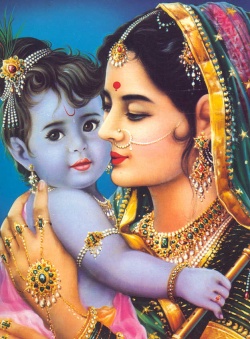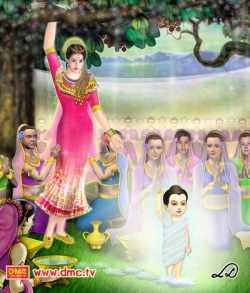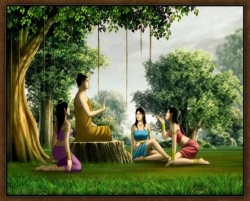Maya, Buddha's Mother
The woman who gave birth to Buddha Shakyamuni is called in the scriptures, Mahamaya, meaning Great Maya, or Mayadevi, the Goddess Maya. In Tibetan, she is called Gyutrulma. In English, she is generally called Queen Maya, a designation that obscures more than it reveals.
Maya is actually the Sanskrit term for Illusion in the sense of an interplay of Substance and Energy that contributes to our believing that there is something "there." (Substance itself can be variously analyzed or described. Buddhists refer to the skandhas or "heaps.") When our bodily organs of perception interact with the interplay, we usually call the product of the interaction, Reality. So Mahamaya actually means The Grandest Deception (or, Illusion) of all -- that which convinces us of Existence.
In the traditional Indian view generally called Hinduism, the three combinants are "personified" as great goddesses. (The other two are Shakti, that is Activity, and Prakriti -- Matter, or what we can call Nature.) There can be no life or existence without any of them, but we rely especially upon Maya. It is her conduct that makes the others perceptible, for without her we would have no access -- we would not be able to read existence or, reality.
In the Hindu tradition, Maya is also understood as the maiden-aspect of the Indian Mother goddess, Kali. She is Mahakali. She is our mother in the sense of the Giver of Perception.
Un-deified, Maya is a "veil of illusion," or a wondrous display, a magical dance -- a trick that employs distraction to keep us bound to samsara, the Wheel of Existences.
Maya is not a Trickster in the sense of an agent that purposely misleads or misguides. She is not Mara in disguise. Her majesty, ingenuity and intricacy generously permits us, or inspires us, to glimpse the possibility of "Enlightenment." It is our own failings that distract us from this objective.
Mythology
Maya's name appears also in Greco-Roman (or, Classical) mythology. There was extensive commercial contact between India and the Mediterranean lands long before the time of Alexander of Macedon (ca. 350 BCE.) However, whether the Greek name had a different origin or not, is not as relevant as the fact that there, Maya or Maia was an earth goddess. Maia is usually explained as meaning Maker, for she is seen as the cause of the spring season when all that we have seen die away before winter now springs back to life. Therefore we have come to use her name to designate (in the northern hemisphere,) May, the month of flowers -- the time of rebirth.
In the mythology of ancient Greece, Maia was once the youngest of the group of stars called the Pleiades (children of Pleione, another name for Aphrodite.) Atlas, their father, was a Titan who was punished for taking part in a revolt against the gods, and so was sentenced to bear the heavens [no, not the world] on his shoulders. Unable to bear their father's humiliation, Maia and her sisters fled to highest heaven and can be seen there as the group known as The Pleiades.
But wait. Maia is called Grandmother of Magic. Seduced by Zeus, she gave birth to Hermes, the Transformer -- the one who is a Master of Disguise, a Trickster and the psycho-pomp (guide of souls to the land of the dead.) The planet Mercury is named for Hermes, and in Sanskrit the name is Budh.
The activity of the child, Hermes (Mercury, to the Romans) is reminiscent of the Indian god, Krishna. While still an infant, Hermes stole the cattle of the sun. From the shell of a tortoise, he created the lyre, and he also invented the flute from the hollow reeds of a marsh.
Barbara Walker (The Woman's Encyclopedia of Myths and Secrets, 1986) points out some other associations. Under the entry Maya:
"Magic," title of the Virgin Kali as the creatress of earthly appearances, i.e., all things made of matter and perceptible to the senses. She also gave birth to the Enlightened One, Buddha.
The same Goddess, called Maia by the Greeks, was the virgin mother to Hermes the Enlightened One, who had as many reincarnations as the Buddha. Sometimes Maia's partner was Volcanus (Greek Hephaestus, the divine smith and fire-god). This was another mythic mating of male fire and female water. Hindus said Agni the fire-god was the consort of Kali-Maya, though he was periodically swallowed up and "quenched" by her. According to the Tantric phrase, the Goddess quenched a blazing lingam in her yoni.
As the virgin mother of Buddha, Maya embarrassed ascetic Buddhists and was soon written out of the script. Like ascetic Christians speaking of Christ's birth, some Buddhists claimed the Enlightened One could not touch his mother's "parts of shame" and so was born through an opening in her side. This mythic Caesarian section seems to have been bungled, for a few days later Maya died -- "of joy," as Buddhist scriptures rather fatuously put it.
Nevertheless, Maya remained very much alive as one of Kali's most revered manifestations, because the very fact of "Existence"-- the material cosmos-demanded her presence. As Zimmer analyzed her:
Mahamaya.jpg
[[File:|thumb|250px|]]
Maya-Shakti is personified as the world-protecting, feminine, maternal side of Ultimate Being, and as such, stands for spontaneous, loving acceptance of life's tangible reality . . . [S]he affirms, she is, she represents and enjoys, the delirium of the manifested forms . . . . Maya-Shakti is Eve, "the Eternal Feminine," das Ewig-Weibliche: she who ate, and tempted her consort to eat, and was herself the apple. From the point of view of the masculine principle of the Spirit (which is in quest of the enduring, eternally valid, and absolutely divine) she is the pre-eminent enigma.
In herself Maya embodies all three aspects of the maternal trinity. Her colors were white, red, and black, the colors of the Gunas, or the Virgin-Mother-Crone. Like every other form of Kali, she was Creator, Preserver, Destroyer. She was also a spirit dwelling perpetually in women. A Mahayana text says, "Of all the forms of Maya, woman is the most important."
Maya's son Buddha [Shakyamuni] was surrounded by her symbols. He entered his trance of meditation under her sacred fig tree, which protected him from the weather. On his return from the soul-journey, his first symbolic act was to accept a dish of curds from a maiden on Full Moon Day in the month of May, the greatest of Buddhist festivals.
Not only the month but many other traditions attest to the great age and wide distribution of the Goddess Maya. She was more than the Maia who mothered Hermes; she was also Maga the Grandmother- goddess who bore Cu Chulainn's mother; and the Mandaean Christian's Almaya, called "Eternity," or "the World," or "Beings"; and Maga or Maj the May-maiden in Scandinavia. Like the Hindu Maya who brought forth earthly appearances at creation, the Scandinavian one personified the pregnant womb of chaos before the beginning: Ginnungagap. In this the World-virgin was associated with the idea of magical illusion, creating "appearances" like her Hindu counterpart.
This universal Creatress-name may have reached the western hemisphere also. The Maya people of Yucatan offered sacrifices in the same way as in northern India, at the same seasons, determined by the same stars. Mayan "scorpion stars" were the same as the constellation Scorpio on Hindu and Greek charts. As in India, Mayan divine images were painted blue and Mayan women pierced the left nostril for insertion of a jewel. Another version of the Creatress seems to have been the Mother Goddess Mayauel of the Mexican Agave, called "Woman with Four Hundred Breasts," with a strong resemblance to the world-nurturing Many-Breasted Artemis and other eastern forms of the deity who mothered all the world's creatures.
Our Mother
Maya is not only the Buddha's mother; she is our mother too. Without her, we would not be here. Without the world of appearances, we could not be born in the precious human body that affords us an opportunity to discern Her, and our own True Nature.
Mother of All Buddhas (Satrig Ersang)
Maya's prophetic dream.
Right after the Birth, which was not "through her side."
Buddha returning to earth after repaying his mother's kindness.
Prayer, Repaying the Kindness of Mothers.
Robin Williamson lyrics for "Maya." *
Purchase remastered cd The Incredible Stringband's [Wee Tam &] The Big Huge, Elektra, orig. release, 1968.
The Stepmother
Seven days after giving birth to the Buddha of our eon, Mayadevi died. Legend has it that was reborn as a deva in the Trayatrimsha Heaven ruled by Indra. Her sister, and likely co-wife, Mahaprajapati, raised the prince. One tradition holds that there were 32 nurses appointed to his care: eight to carry him around, eight to suckle him, eight to bathe and dress him, and another eight just to amuse him.
______________________________________________________________
See the Tarot, the 21st or ultimate card of the major arcana, called The World.
Enlightenment: The word, bodhi is better translated, Awakening.
- Maya (Lyrics by Robin Williamson, The Incredible Stringband, 1967. )
MAYA (Robin Williamson. The Incredible String Band, 1967.)
Dust of the rivers does murmur and weep
Hard and sharp laughter that cuts to the bone
Ah, but ever face within your face does show
Going gladly now to give himself his own
And twelve yellow willows shall fellow the shallows
Small waves and thunder be my pillow
Upon the gleaming water two swans that swim
And every place shall be my native home
The east gate like a fortress dissolve it away
The west gate like a prison O come break it down
Island I remember living here
Wandering beneath the empty skies
In time her hair grew long and swept the ground
And seven blackbirds carried it out behind
It bore the holy imprint of her mind
As green-foot slow she moved among the seasons
The great man, the great man, historians his memory
Artists his senses, thinkers his brain
Labourers his growth
Explorers his limbs
And soldiers his death each second
And mystics his rebirth each second
Businessmen his nervous system
No-hustle men his stomach
Astrologers his balance
Lovers his loins
His skin it is all patchy
But soon will reach one glowing hue
God is his soul
Infinity his goal
The mystery his source
And civilisation he leaves behind
Opinions are his fingernails
Maya Maya
All this world is but a play
Be thou the joyful player
The wanderer no sense does make
His eyes being tied in the true love's knot
The trees perceive his soul
Do not detain him long
Dear little animal dark-eyed and small
Caring for your fur with pointed paws
This hawk of truth is swift and flies with a still cry
A small sweetmeat to the eyes of night
O dandelion be thou thine
Reflecting the sun in sexual glory
In every-changing tongues
The every-changing story
The book, man, bird, woman, serpent, sea, sun
Blessed O blessed are they of the air
Your eyes are the eyes
Of the glad land
Ye twelve that will enter the seasons
The great ship, the ship of the world
Long time sailing
Mariners, mariners, gather your skills
Jesus and Hitler and Richard the Lion Heart
Three Kings and Moses and Queen Cleopatra
The Cobbler, the Maiden
The mender and the maker
The sickener and the twitcher
And the glad undertaker
The shepherd of willows
The harper and the archer
All sat down in one boat together
Troubled voyage in calm weather.


